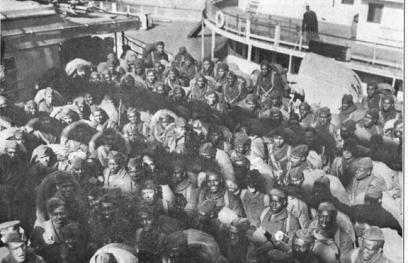|
This
biographical sketch was researched and written by
Barbara B. Barksdale, president of the Friends of
Midland Cemetery organization. The tremendous
work of that organization in preserving not only the
historic Midland Cemetery in Swatara Township, but in
uncovering the vibrant history of Steelton's African
American community, is featured on other pages on this
site. One of their recent projects involved
rescuing and preserving membership records of
Steelton's first African American American Legion
post, the Andrew Askins Post
479. The records--hundreds of membership
cards dating from 1927-1935--were saved from an
abandoned house and transcribed by volunteers.
Those cards, which were almost lost to historians,
told a story of Steelton's African American
involvement in the "Great War" and yielded a snapshot
of the lives of those veterans in the two decades
following the war in this steel town. This
column was first published in the Middletown Press
and Journal, November 5, 2003, and Ms. Barksdale
has kindly given her permission for its republication
here.
|
|
Some months ago,
I wrote a story about the veterans of the American
Legion “Andrew Askins,” Post 479. As a continuation of
that story, I wanted to introduce you to a very
special man, Trennor Thomas Beckwith, a longtime
resident of Steelton. Trennor Thomas Beckwith was born
Aug. 27, 1893 to Charles W. and Mary L. Beckwith. Most
of his life, his family resided in the 2-1/2 story
wooden frame house located at 162 Ridge St. in
Steelton. Trennor attended the Hygienic
School located on Hygienic Hill at Bailey and
Adams Streets. With an aptitude for study, he mastered
the Steelton School District curriculum graduating
in 1912 in a class of five girls and five boys.
With the help of Prof. James Howard, an educator who
could see the academic talent of Trennor, it impressed
upon him and the other students the rewards of
learning. Professor Howard, being an African-American
as well, knew the importance of a sound education.
Trennor and the other students probably would credit
the professor for being a strong mentor in their
lives.
What
Trennor did prior to the war is unclear. He was 19
when he graduated from high school and it was several
years before America became part of the war
(1917-1918). However, I surmise that he, like so many
other men, probably went to work in the Bethlehem
Steel Company. By the age of 25 he enlisted into the
United States Army. On May 28, 1918 he became a member
of the 351st field artillery unit during World War I
and according to his headstone became a corporal. His
membership post card shows that he was honorably
discharged on Mar. 6, 1919. It is noted that Trennor
became the post adjutant at its conception around 1927
until the mid-1930s. The post was located on the
street that he lived on making it convenient for him
to be available.
The
photograph at left is from Emmett J. Scott's American
Negro in the World War (1919). The original
caption is "Part of Squadron 'A,' 351st Field
Artillery, colored troops on the Transport
Louisville. These men are mostly from
Pennsylvania." This photograph is from chapter
III, betwen pages 64 and 65.
Trennor
T. Beckwith could easily be one of these men facing
the camera.
With the
position of adjutant came a large amount of
responsibility and respect. Reviewing the numerous
cards that contained his signature shows that he made
an effort to encourage others to join the post and
share in the rewards of being an American war veteran.
One of his duties was to inform the honorably
discharged men of the benefits that were available to
war veterans. Of course, a membership meant you could
attend the many events, dances, meals and social
gatherings. This gathering of men and women helped to
relieve the daily stress of everyday life and was
something to look forward to after a week of hard
work. In the early part of the 20th century, based on
the history of this country, I can only envision the
hardships that so many people had to endure, but with
the help of the African-American Andrew Askins Post
479 it gave a relief that only its walls could give.
As they say, “If these walls could talk.” Trennor made
sure that the veteran men of color had a place to call
their own.
Trennor had
a long working history in and out of the post, some of
which was documented on his cards. Information
obtained from his membership cards show that he worked
as a steelworker in 1929 for the Bethlehem Steel
Company. In 1930, he was listed as a clerk. I also
found him listed as a census taker in the Borough of
Steelton for the 1930 census. In 1933 he became a
waiter for several years and he is listed as a bellman
during that same time period. By 1934 he was a
messenger and later in that same year became a clerk
again. From all appearances it seems that Trennor was
a very busy man. Judging from his handwriting he took
pride in his work and what he stood for. In my
archives of papers, I found his name handwritten on
some of the papers. You could feel his determination
as you viewed the letters that formed the sentences.
The flow of the ink from the pen being heavier in some
places and lighter in others could be detected as he
carefully wrote out his information, bringing forth
his intensity at communicating the task at hand. This
evidently led to his involvement in the community and
political activities.
I had the
pleasure of speaking with Jacob Franklin, another
longtime resident of the area, and asked if he knew of
Trennor Beckwith. To my delight he was able to
recollect that Trennor was a brilliant man with a
strong ability to speak publicly. Franklin told me
that Trennor would set up the program for Memorial
Day, May 30, and would recite the Gettysburg Address
every year at Midland Cemetery in Swatara Twp. I found
this information in my papers also which adds to his
story. He was described as a handsome person of
caramel colored skin, weighing about 200 pounds, 5
feet 7 inches with a full head of soft curly hair. It
was Clayton
Carelock, a former resident of Steelton and one
of my board members, which informed me that Trennor
worked as a janitor in the Dauphin County Courthouse.
He, like so many of his educated brothers, could not
get a job that was above the level of laborer.
Regardless of his situation, he kept a pleasing
personality and was a great role model who touched
many lives.
His life,
his story of the post and community activities, will
not be forgotten. He will live on in the memory of the
Midland files. Trennor never married and I could not
locate any information that he fathered any children.
He died July 27, 1957 and was buried in the historic
Midland Cemetery in Swatara Twp. next to his parents.
For more
information on Trennor or any resident of the Midland
Cemetery please contact the Friends of Midland at
717-939-0242 or e-mail [email protected].
For research information, view our site at http://www.afrolumens.com/rising_free/friends.html.
|
